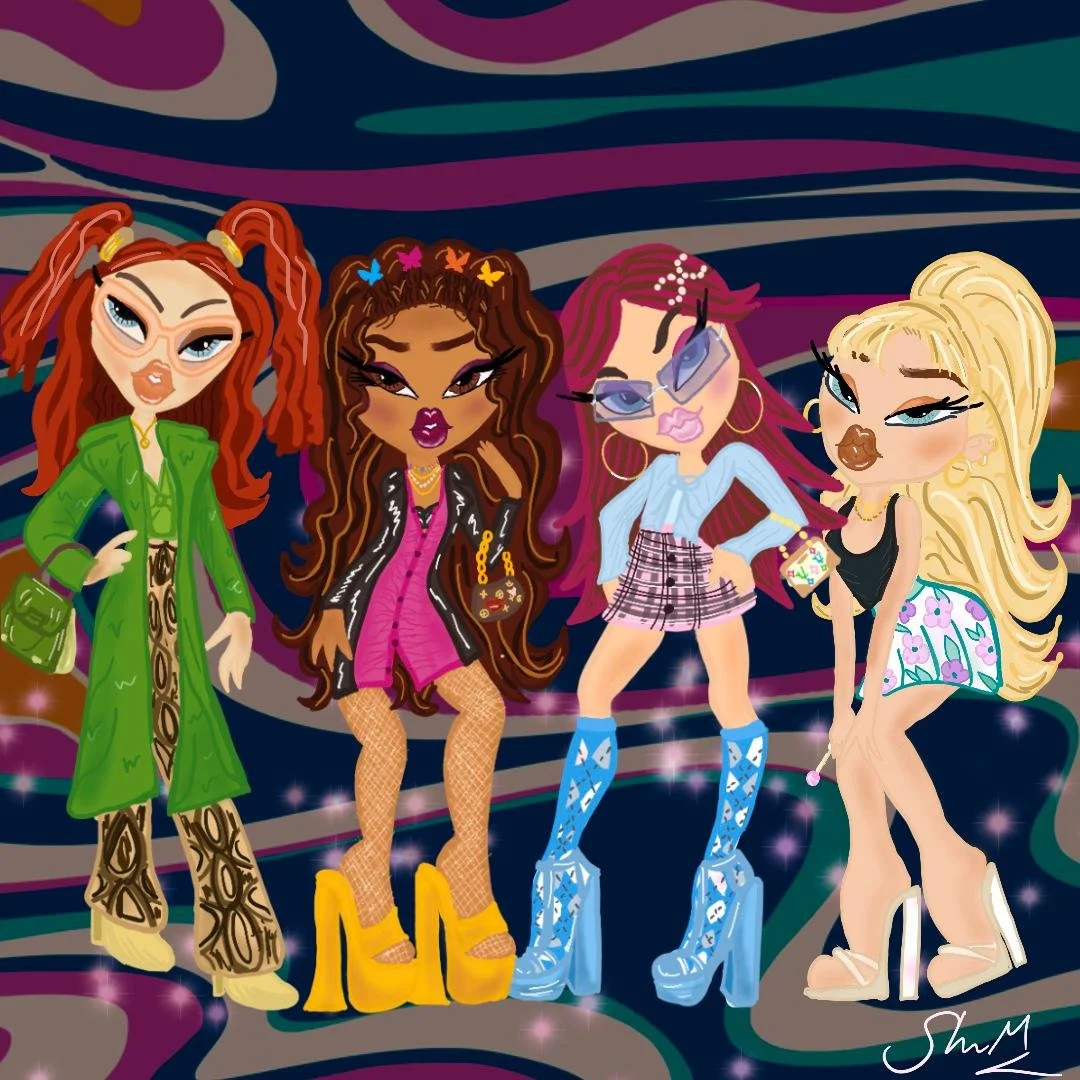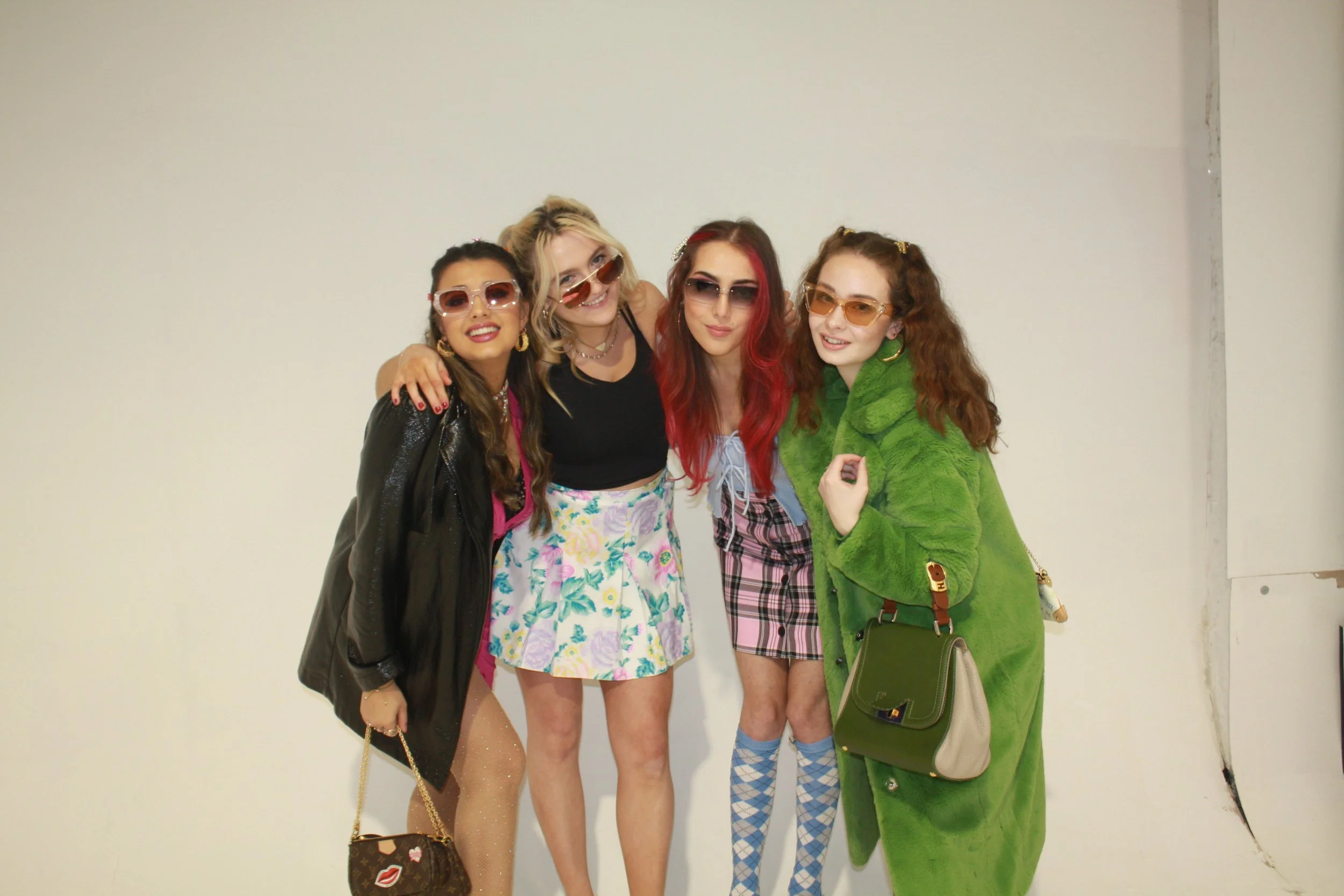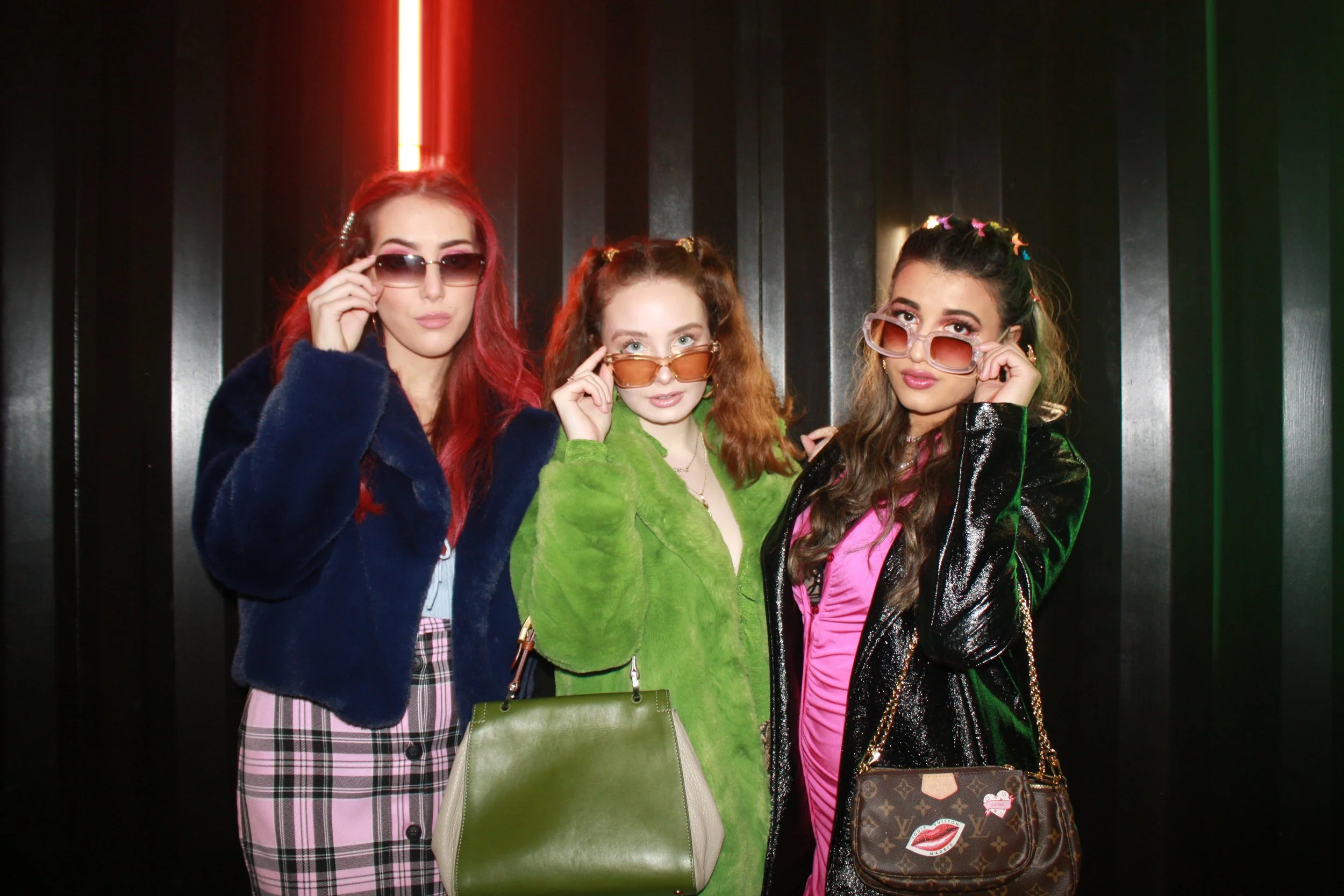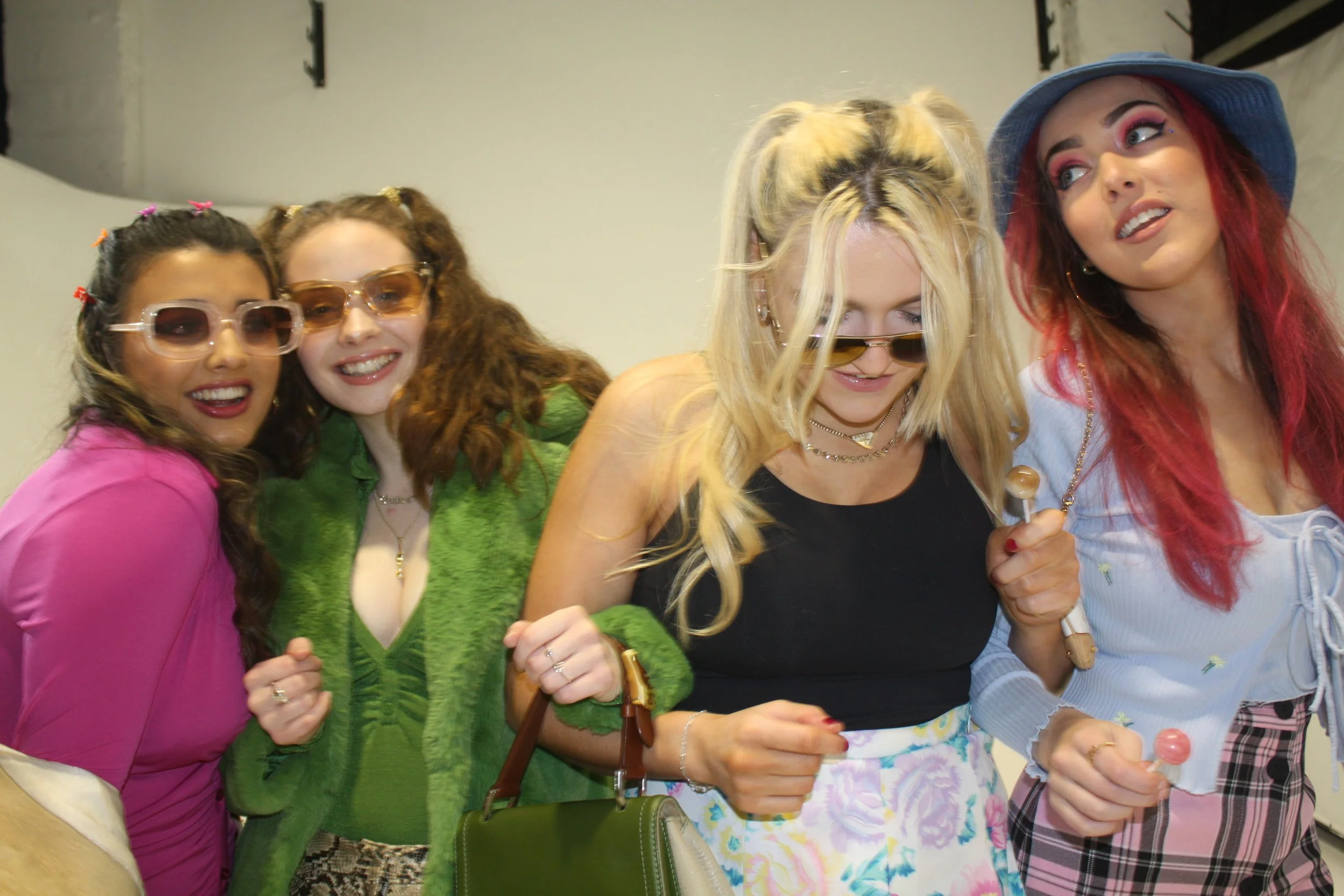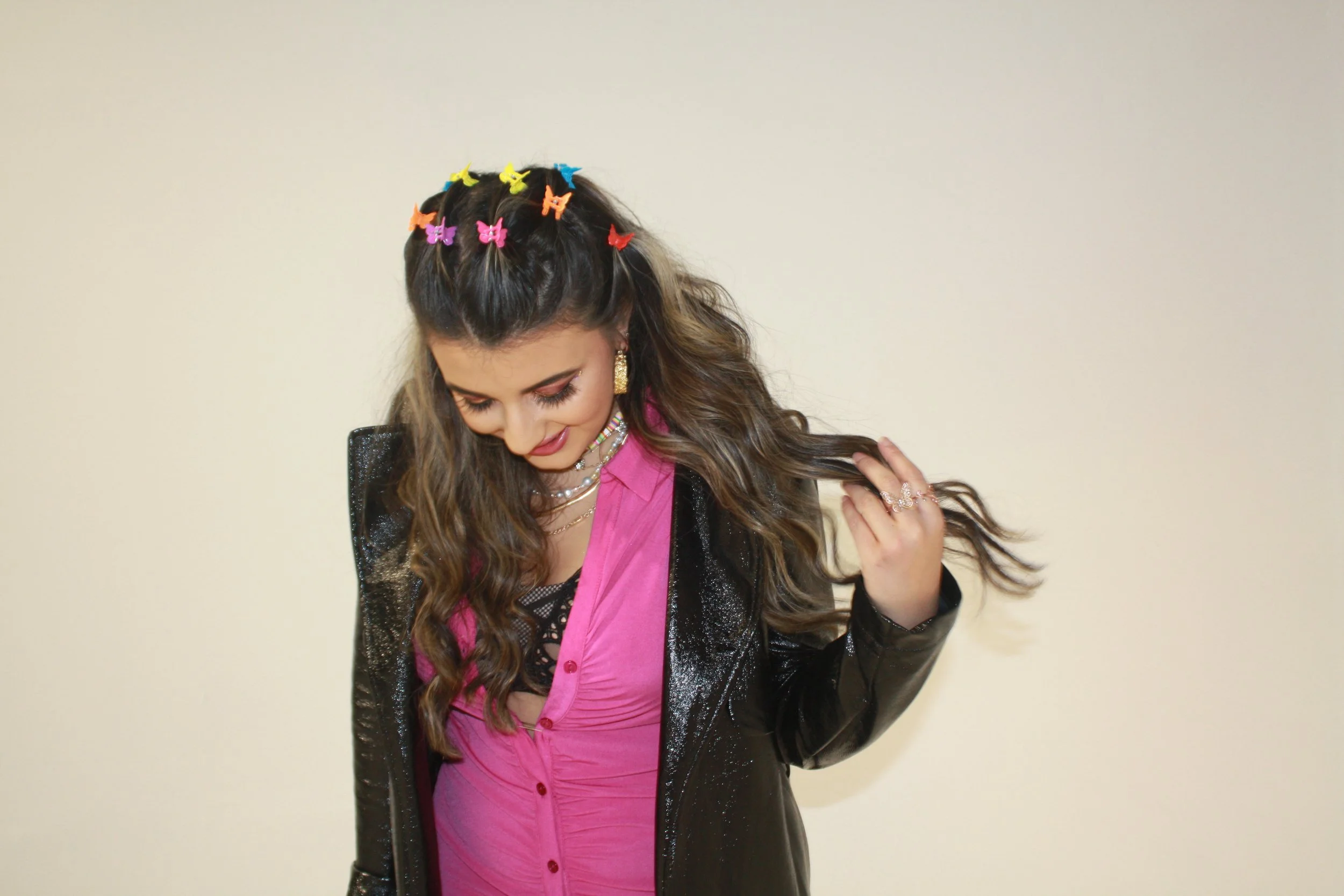Bratz and beyond: Girls with a Passion 4 Fashion!
Photography by Grace McWilliams, Stylist. Models Kathryn Hampson, Alice Solerod, Shona MacPherson and Honor McWilliams. Words and Styling by Honor McWilliams. Graphic illustration by Shona MacPherson.
Openly hated by parents. Constantly entrenched in legal disputes. Few dolls can be considered as polemic, nor as powerful, as the Bratz.
I remember getting my first Bratz doll for my 6th birthday from my aunts, much to my mum’s horror. Boldly donning matching snakeskin trousers and boots, a black asymmetrical bodysuit and fluffy feather boa, she was nothing like my barbies… or any other doll I had ever seen.
Little did I know, Bratz dolls would go on to shape both my childhood and my sense of style right into adulthood. So much so, at the current age of 22 I’ve felt compelled to write this whole article, dress up as a Bratz doll, and make my sister and friends do the same. Yes, I’m aware that this is pretty sad. Although I’m definitely not the only one who thinks that Yasmin, Cloe, Sasha and Jade have influenced, and continue to influence, the fashion of so many individuals and brands.
Released by MGA Entertainment in 2001, Bratz dolls were undeniably ahead of their time. Look no further than the rise of the y2k aesthetic dominating our social media and streetwear today, replete with low-rise jeans, fur-lined jackets, audacious sunglasses and knee-high boots. The Bratz Challenge, peaking in 2018/19, saw a host of youtubers re-creating the provocative makeup that defined the dolls. Even now, Bratz boasts over 809k followers on Instagram and has collaborations with fashion labels such as Daisy Street and GCDS. With 1.7 trillion views of user generated Bratz content between 2019 and 2021, their indelible mark on popular culture over 20 years later is irrefutable.
As arguably the only real contender to Barbie’s incessant reign over the doll market for the past 60 years, Bratz offered something totally different to young girls at the start of the new millennium. And fashion was the foundation of their fresh image.
Masters of bold patterns, daring materials and bright colours, every look was a clear statement of their personal style, with an intrinsic self-confidence and self-assurance. The dolls dressed with fearlessness. They were characterised by their conviction.
Even more importantly, Bratz celebrated difference and embraced inclusivity in a way that few dolls had in the early 2000s. Barbie, a blonde-haired, blue-eyed, girl-next-door figure, was placed centre stage in her universe, with her friends and other characters serving as mere after-thoughts. It really was just about a Barbie girl in a Barbie-centric world. Bratz, on the other hand, placed friendship, diversity and ‘girl-power politics’ at the forefront of their image. The core set of dolls - Yasmin, Cloe, Sasha and Jade - all from different cultural backgrounds were equally as important, equally as significant, and given equal attention. Iranian born Isaac Larian, the CEO of MGA Entertainment, explained his refusal to ‘label’ the racially diverse dolls to the New Yorker in 2006: ‘Don’t call them African American. Don’t call them Hispanic. Don’t call them Middle Eastern. Don’t call them white. Just convey the difference.’
And convey the difference they did. Bratz placed girls of any race and their style in the mainstream, deviating from the normative white, middle-class culture idealised by most dolls and children’s toys. Young girls had the chance to explore and perceive race as part of their identities by playing with Bratz dolls, fostering a more realistic expression of individualism and race in relation to their own femininity. Bratz re-imagined a more empowering reality.
Yet the Bratz were certainly not without their flaws. The marketing of the dolls was inherently materialistic and hedonistic. They seemed to be on a perpetual shopping spree for their endless social activities, from nights out to camping trips to catwalks. One Bratz commercial famously coined the phrase “Don’t theorise… accessorise!”. Although I may take inspiration from the Bratz style, something tells me this is maybe not a mantra I should adopt writing my dissertation this semester! Some even accused the multi-ethnic dolls of commodifying race, reducing it to a glamorised consumer accessory. Like Barbie and other dolls, Bratz were equally guilty of perpetuating an unrealistic body image. Their tiny waists blatantly contrasted with their disproportionately large heads, huge almond shaped eyes and full lips.
Parents took particular issue with their image, claiming that Bratz were dressed inappropriately and sent out the wrong message to young, impressionable girls. Their hooded, icy-hued lids, elongated lashes, pouting lips, daring streetwear and platformed shoes blatantly contrasted the inherently middle class, white, traditionally feminine ideal incarnated by Barbie.
There was nothing natural about a Bratz doll. But that was irrelevant to me when I got my first one on my 6th birthday. All I saw was a really unique doll that had a great sense of style.
And honestly, the extent to which Bratz can be considered natural is still irrelevant to me now. Women should feel empowered to wear as much or as little makeup as they want. Women should feel equally free to wear modest outfits, or reveal more skin, or both, if that emboldens them. We should not devalue feminine expression if it isn’t obviously ‘natural’ or ‘low maintenance’.
Bratz presented a femininity that was unapologetic and non-conforming to a white patriarchal ideal. The very name of the doll line was prophetic, reflecting contemporary tongue-in-cheek feminism. Words such as ‘diva’ and ‘bitch’, almost exclusively used as insults towards women, have been reclaimed by femme-centred communities to undercut the misogynistic and disrespectful connotations that were inherent to the use of these terms. In a similar way, openly identifying as a ‘brat’ invites young women to construct a proud and unashamed self-image and be vocal about what they want.
Bratz have not just resurfaced as a fleeting online trend. Bratz represented inclusivity, remodelled fashion trends and revolutionised femininity in the early 2000s. This ethos endures. Today, social and independent media not only embraces but actively reflects the very essence of the fashion-forward doll line.
Bratz raised an entire generation of girls. Today these girls, now women, are at the forefront of forging a culture of self-empowerment through feminine expression. They’re simply finishing what Cloe, Yasmin, Sasha and Jade started.
Read More
Benberry, Imani. “The Bratz Dolls are Style and Female Empowerment Icons for Gen Z.” Study Breaks. September 13, 2020. https://studybreaks.com/thoughts/bratz-dolls/
Hazlehurst, Beatrice. “A Brief Investigation into the Complicated History of Bratz”. W Magazine. June 1, 2021.https://www.wmagazine.com/culture/bratz-dolls-anniversary-deep-dive-history
Vient, Corrine.”The Triumphs and Drawbacks in How Bratz Dolls Paved a New Path for Femininity and Sexuality.” Medium. June 4, 2020. https://medium.com/@corinnevient/the-triumphs-and-drawbacks-in-how-bratz-dolls-paved-a-new-path-for-femininity-and-sexuality-c9ef2109bab8

